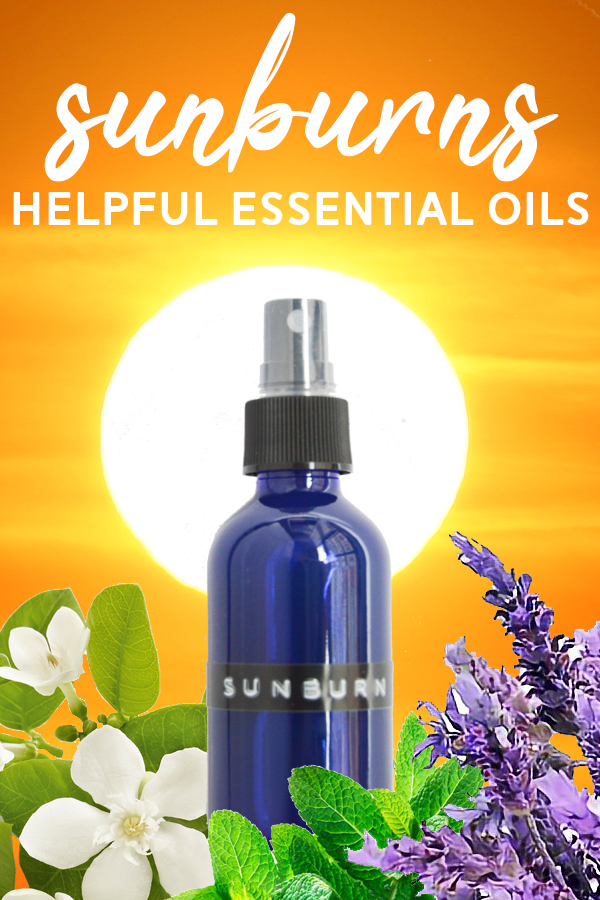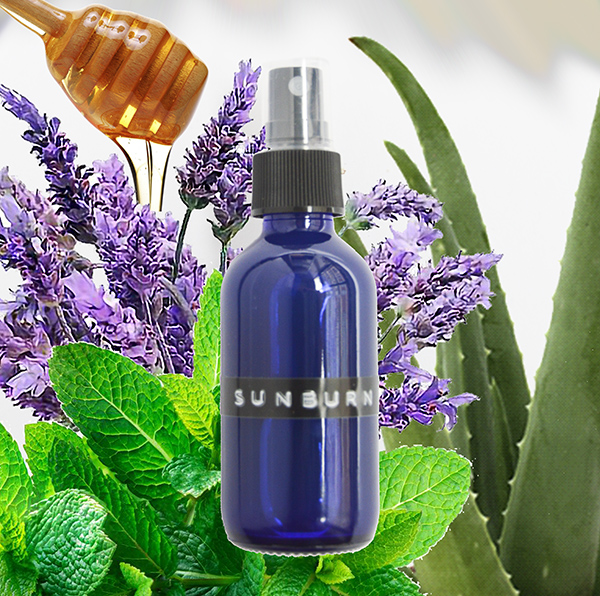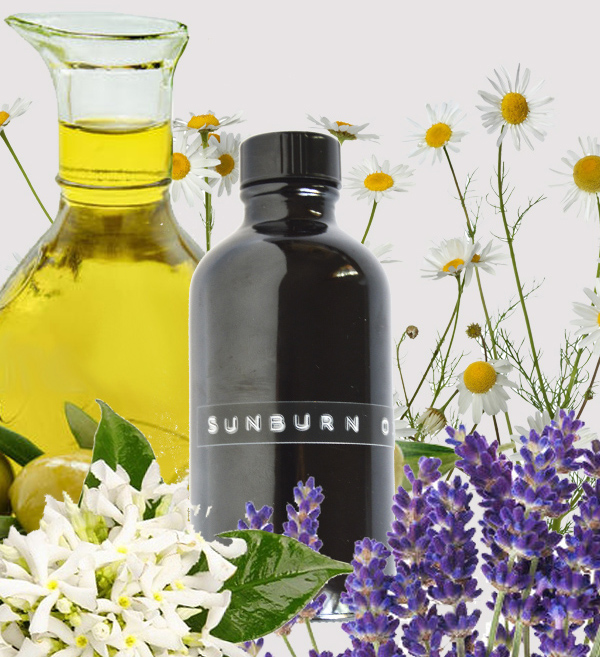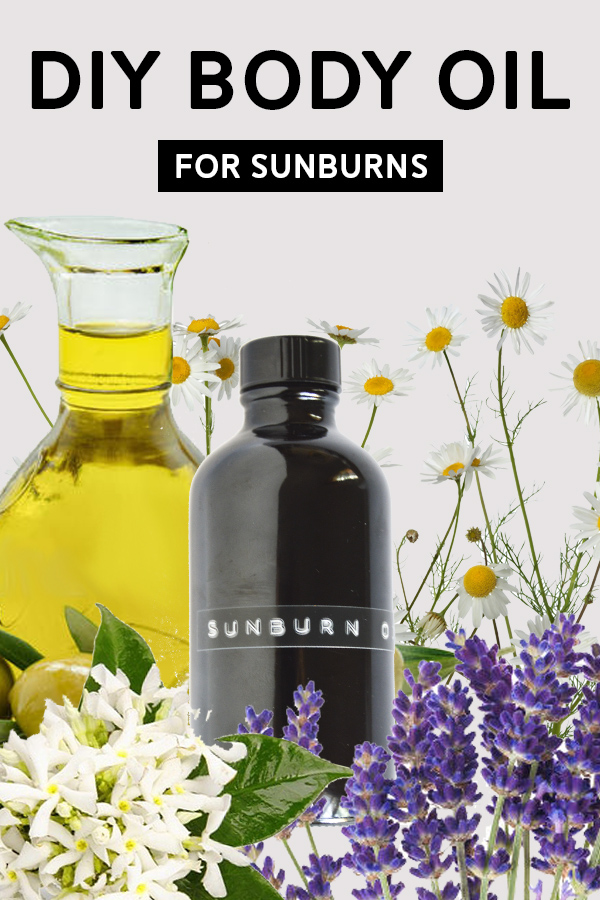
It’s that time of year! By now I think we’re all well aware of the risks associated with unprotected sun exposure. Hopefully all of us lather on that SPF before heading to the beach! But as cautious as I am, I don’t think I’ve ever gotten through an entire summer without at least a mild sunburn. And it usually happens right around the start of the season. Should you find yourself resembling a lobster at any point this summer, these blend recipes and essential oils for sunburns will help relieve your skin.
I’ll start by just breaking down where to start as far as specific essential oils and carriers. Then we’ll get into the blend recipes I use and would recommend. As always, customize within my suggestions so that the blend works for you!
It’s going to seem like a lot of information and options, but I want these posts to be as exhaustive and helpful as possible. Because there is so much to share, I’m going to organize it similar to the way in which I did the essential oils for rosacea series. This is the primary general post, and it links out to separate blend recipes.
Best Essential Oils for Sunburns
Links are to Plant Therapy essential oils, a brand I personally trust, use and love. They are affiliate, however I do not work directly with them and am in no way sponsored by PT (I wish lol).
To overly generalize, the essential oils below are included on the list because they’re calming and healing to the skin and burns in particular, and/or because they provide a cooling sensation upon application.
- Lavender – If you’re just going to use one essential oil for your sunburn, this should be it. And if you’re going to make a blend, I’d highly recommend including it. Lavender is calming to the skin and nervous system and is also antiseptic. It’s particularly indicated for burns and sunburns.
- Peppermint – Peppermint is cooling to the skin when applied in small doses and antiseptic. Key words: small doses. If using it in a blend, have the bulk of the oil composition be Lavender (or a similar, gentle essential oil) with just a small concentration of peppermint (or other cooling oil). I’ll get into numbers below, don’t worry.
- Chamomile – You could use Roman or German chamomile, as both are good for burns and wound care. I personally prefer German chamomile, as it’s incredibly gentle.
- Geranium – Geranium is widely used in skincare. It can be particularly beneficial for burns.
- Sandalwood – Sandalwood can support irritated and inflamed skin.
- Neroli – Neroli is great for sensitive skin in general and has antiseptic properties.
- Eucalyptus – Like Peppermint, Eucalyptus has a cooling effect on the skin in small doses and has antibacterial and anti-infectious properties.
- Tea tree – Tea tree oil is like nature’s first aid kit. It has antiviral, antifungal and antibacterial properties, making it helpful in preventing infections. If a sunburn is severe, it’s a great option. It also has a cooling effect in small doses.
Best Carriers for Sunburns
You could use one of these carriers or combine them. I like including several in the topical treatments I make for sunburns.
- Aloe vera – Aloe is the first thing that comes to most of our minds when we think of a sunburn. It’s anti-inflammatory and healing, and also provides a cooling sensation.
- Extra virgin olive oil – Extra virgin olive oil is high in vitamins and minerals. Traditionally used to heal burns for centuries.
- Wheat germ oil – Wheat germ oil is an antioxidant and useful for damaged skin.
- Calendula infusion oil – Calendula infusion oil (olive oil infused with the Calendula officinalis plant) is healing and moisturizing. Traditionally used in all sorts of first aid ointments and lotions for damaged, dry skin.
- Honey – Honey is antibacterial and anti-inflammatory. It can be used in blends and for dressings if the burn is severe. You’d mix the essential oils in the honey then apply a thin layer to the gauze dressing that you’re going to then drape over the burn.
How to Soothe a Sunburn with Essential Oils
Now that we’ve gone over the best essential oils and carriers for sunburns, let’s dive into some specific modes of application.
Cooling Spray for Sunburns

Spritzing a cooling blend over sunburnt skin feels heavenly. It’s also a great option if your sunburn is painful to the touch, and you’d rather not rub a blend into it.
If you want to keep things super simple, lavender hydrosol (floral water) can act as a great soothing spray. In this older post I show you how to make floral water (just sub German chamomile with Lavender). You can buy Lavender hydrosol already made as well. Just transfer to a spray bottle. I’d recommend storing in the refrigerator so it feels even better on your sunburn. While Lavender is calming and soothing to the skin, it doesn’t provide the same cooling effect as, say, peppermint essential oil.
Personally, I use a spray that I made using aloe and peppermint (along with other ingredients) for more of a cooling sensation. I still store it in the refrigerator (cool and prolonged shelf life). It feels AMAZING when spritzed over sunburnt skin, and you can make a bottle of it now that will last you through the summer. I sometimes use it when I’m feeling flushed and overheated or having a rosacea flare-up—no sunburn required. DIY Cooling Sunburn Spray RECIPE HERE.
Body Oil for Sunburns

In addition to a spray, you can use a body oil to help with a sunburn. You’ll notice the “cooling” oils and carriers (peppermint, eucalyptus, tea tree, aloe) aren’t included in the particular body oil blend I use. This is because the focus is more on calming, moisturizing and healing the sunburnt skin, rather than on an immediate sensation of relief.
You can, however, customize your blend to include one of those oils (in *small* dilution). Or, after gently massaging the body oil into your skin, you could apply some aloe vera gel on top for that ahhhh cooling sensation.
Apply a body oil 2-3 times throughout the day, but especially before you go to bed. Gently massage it over your sunburn, ideally after showering so that the skin is clean and moist.
I use extra virgin olive oil, calendula infusion oil and wheat germ oil as my base. For essential oils, Lavender is the primary focus (it’s so good for burns—don’t exclude it!). I also use Chamomile, Neroli and Geranium. All are gentle and calming, which is important when dealing with inflamed, angry sunburnt skin. DIY Body Oil RECIPE HERE.
Simple Aloe Vera Rub for Sunburns
Somewhere between a spray and a body oil, you can use aloe vera gel and 1-3 essential oils to make a simple, soothing sunburn rub. Using the above list of recommended essential oils for sunburns, pick 1-3 with aloe vera gel as the carrier. Here’s a simple recipe I love:
INGREDIENTS
- 4 oz (= ½ cup) Aloe vera gel
- 18 drops Lavender
- 6 drops Chamomile (I’m linking to German chamomile but Roman works here, too)
The above will yield 4 oz of aloe vera rub at a 1% essential oil dilution. Typically for topical application with adults, I recommend a 2% dilution. But given the skin is burnt and irritated, I’d reduce that a bit.
Mix well and apply to sunburned skin as needed throughout the day.
Let me know if you have questions in the comments! I am admittedly way more responsive on Instagram, so if it’s important, you can also always DM me. 🙂
xo Nicole
The statements and blends referenced in this post have not been evaluated by the Food and Drug Administration. Products and/or information are not intended to diagnose, treat, cure or prevent any disease. If you are pregnant, nursing, have a medical condition or are taking any medication, consult with your physician before using any essential oil or blend.
I’m a Certified Holistic Aromatherapist through the Institute of Integrative Aromatherapy and only share blends with you that I’ve personally used and from which I’ve benefited. I stand behind them 100%! Essential oil blends are, however, most effective when made with individual needs, goals and personality in mind.









